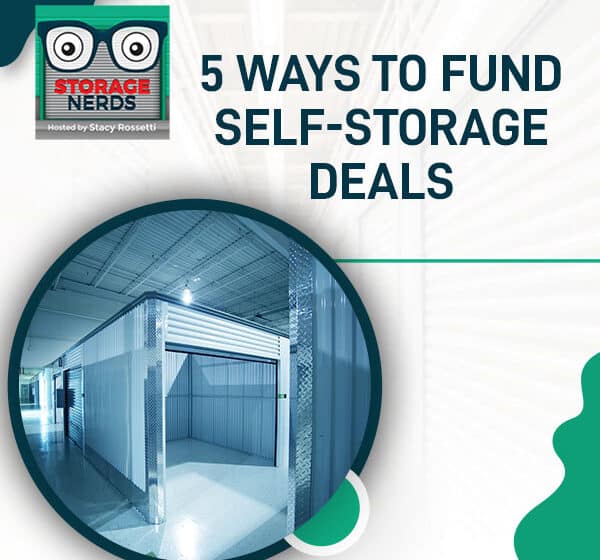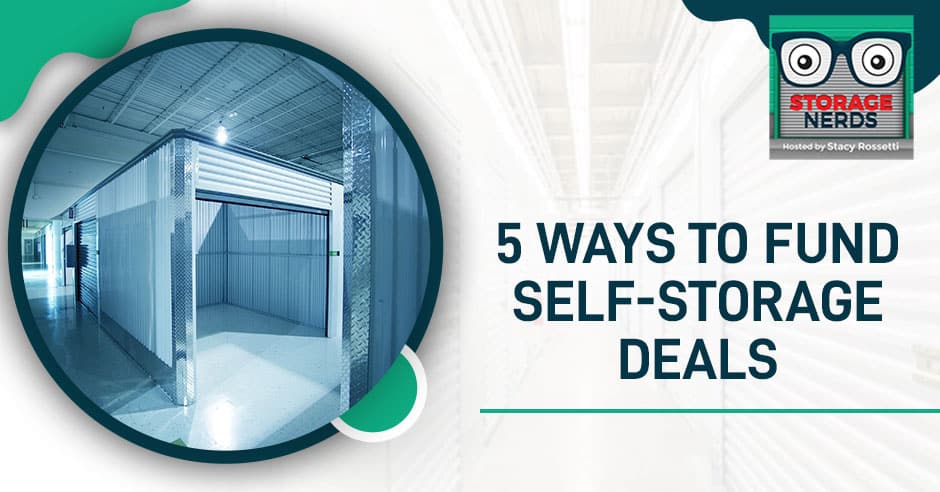Finding the cash to fund deals can be frustrating. In this episode, Stacy Rossetti shares her experience finding her facilities and acquiring them, the five ways to fund self-storage deals, and the whole process of how she made offers with help from her virtual assistants, who put together the executive summary. Tune in to this episode to gain more insights!
Love the show? Subscribe, rate, review & share! https://stacyrossetti.com
—
Watch the episode here
Listen to the podcast here
5 Ways To Fund Self-Storage Deals
I know a lot of you bought the course for the Black Friday sale. We had the course on sale for 75% off. I’m looking forward to working with you when you buy the course. For everybody that bought the course, you get a free strategy session with me. Make sure that you book those. You can use that for deal analysis or get started if you want me to coach you. Whatever you need help with. Make sure that you keep that link so that you can spend some time with me, and then I can get you started or I can run bill analysis.
I got an email right before this. Some random person emailed me a deal and was like, “Is this a good deal?” I write back and say, “Honestly, I can’t look at a deal and tell you if it’s a good deal or not. I need to be able to run a deal analysis. I have to have all of the numbers, so you’re more than welcome to set up a consult if you want, or you can buy the course and go through that and learn how to run a deal analysis yourself.“
That’s what I wrote to her and I’ve never heard back. That’s what we’re going to do in this episode. We’re going to talk about running the deal analysis and then all the ways that you can finance deals. I have a deal here. You guys all know, or if you don’t know, I have thirteen virtual assistants that work for me. They do acquisitions and basically find facilities for students inside the coaching program. You can hire one of my virtual assistants to find a facility for you and do all the work.
I’m going to go over one of the deals that one of my students found. We have a student that lives in Las Vegas. She wants to buy something on the West side. She wants to be either in Utah or Nevada. One of our virtual assistants is doing a fantastic job of calling every storage facility in Nevada and Utah and seeing if anybody wants to sell within her parameters. Everybody has different parameters. We all have money or don’t have money.
We all have different risk levels and things like that. I don’t know why but tell me the answer to this because I have no idea. Why does the West Coast think that everything should be way more expensive? I feel you can get such good deals on the East side of the country or on the Central side. When you start getting over to the West side, everything gets so expensive. The truth is they don’t make any more money than anybody else. I’ve always been running numbers and I’m thinking with the idea of what your price is as a seller. How would anybody make money? Finding a good deal on the West side is very difficult.

Kevin says he’s in Utah. We’re calling in Utah and Nevada. You guys tell me how many storage facilities there are in the State of Nevada. You can Google it if you want, but there are not a lot of storage facilities in the State of Nevada. I tell my virtual assistants, “You can’t start calling owners until you have a list of 300 storage facilities.” Christian is my virtual assistant that was calling in Nevada. We only found 450 storage facilities in the State of Nevada, so there’s not a lot. Nevada is a whole bunch of nothing anyways, except for in the way North and South. Out of those 450, I would say not half, but a quarter of them would be a primary market because Nevada obviously is like Vegas.
A Tour On The Facilities
We don’t look at all in Vegas. Vegas is way too expensive, so we don’t look in Reno. We’re looking out at the smaller tertiary markets. It is what we’re doing, and that’s what Christian is doing. He came across this property and I wanted to show it to you guys. I will run through how we found it and how we made offers. We were going to fund it if we purchased it and then you guys can walk through the steps with me. Let’s go ahead and go through that property now. What I’m going to do is I’ll pull the information up. Remember I told you that Christian builds a list and then he starts to call? His parameters are secondary and tertiary markets.
That’s where we look for our facilities. We do a lot of virtual driving for storage. We call on Google Maps but look for facilities that are not on Google Maps. Let’s try to look at this one that he found, and I want to go through the whole process of what we did. You guys can give me your opinion on what the offer should be. We already put an offer in and it got rejected because facility owners think their facilities aren’t worth way more. You guys tell me if you would’ve offered more or what you guys think. Let me pull this up and Route 89 storage is the facility. We use Pipedrive to manage all of our leads and then I’m going to show you our process.
All the information you can see is on the left here. I’m going to pull up our executive summary. I’ll pull up the Google Drive folder, and then I’m going to also pull up the Deal Analyzer. The process for us is once we find a facility to build a Google Drive folder, and then inside the Google Drive folder is where we put all the information that we can possibly get, not only from the owner but also about the facility. You can see here that inside the folder, we’ve got Regrid. I’ll show you what Regrid is. Regrid is where you can find boundaries and things like this. This is public data on the property. If nobody has heard of Regrid before, it’s completely free to use.
They’ll try to upgrade you, but what you need, most of it is going to be free. We have pictures of the facility, the offer letter, and maps of the facility. Maps is where it’s located, the executive summary, demographics, Deal Analyzer, county info, and competition. This is what our folder looks like. This is everything that we need in order to make a decision on whether or not the deal is a good deal. As I told you, I got the email from some random person I didn’t even know. They sent me over to a facility and said, “Is this a good deal?” It happens all the time. It’s frustrating. The truth of the matter is I can’t look at a deal and figure out if it’s a good deal.
You have to run a commercial deal analysis. I’m going to show you how to do that. Commercial deal analysis means what the demographics are. What does the competition look like? What does the property report card look like? What are they paying taxes? What does the land look like? You have to look at so many different things. Let me get in here and show you what it looks like with this deal here. The way that I work with my virtual assistants is they put together what’s called an Executive Summary. He took a snapshot and let me know that this facility right here is competition.
Obviously, in competition, there’s a lot of space for them to grow, whereas, on this one, there’s no space to grow. That’s number one. That’s why it’s so important to get Regrid and see the boundaries and how big the space is. Let’s take a look at this thing. This is Routh 89 storage and then it’s all fenced in. There’s a gate. It looks like it’s open and not electronic. He probably comes over and opens it and then closes it at night. There’s some little room and building. This is an office or something. Pictures tell a lot. These probably are 5×10 on the end. We can look at the Deal Analyzer and look at the numbers.
There’s a little opening right here, so you can walk in. We have that too in our facilities. You’ll have a gate that you can open and close with the keypad. It looks like you can roll this side. We have actual gates where you can open the door and close it in case somebody gets locked in or something because every once in a while, the gate will break, and then somebody’s stuck in there or something. That has happened before. It looks like there’s a gate over here opening, and then there’s another opening. There are a couple more openings over here, but that’s what it looks like right there. We’ll look at the maps.
The map is where in the state it is located. I can see that this is in Provo. Provo is a super expensive area. Is this primary, secondary, or tertiary market? What do you guys think about this? I know that Provo is a super primary area. Gunnison is the name of the town. It’s a little tiny town and there’s a centerfield. I guess there are two towns right next to each other. The demographics are a five-year period vintage 2020, latitude and longitude. Centerfield has 1,335 people in it. It looks like it’s a declining population. It’s declining at negative 0.22% annually and decreased by 0.45%. The population is 1,341. We also put the 3, 5, and 10-mile radius.
Within a 3-mile radius, there are 5,000 people. In a 5-mile radius, there are 5,000. In a 10-mile radius, there are 7,400. Would you consider this primary, secondary, or tertiary market, especially in terms of where it’s located next to Provo. Aida says it’s tertiary. Here’s the county information. This is the Property Report Card. They’re going in and pulling this off of the county website. There is the address, what they’re paying for, and stuff. The value is $312,000. That’s reasonable to me. The taxes in ’22, they paid $3,600, and in ‘21, they paid almost $3,900. Taxes went down. It’s important to look at all this.
This is more data from the county websites that he could find on the deal. Sanpete County is what he went in, and then the actual acreage is 0.8 acres. I ask him, “How much acreage do they in?” It’s 0.8 and there’s no place to grow anything or to add on. It’s a very good first-time facility. If you start out and learn what you’re doing and stuff, this is a good facility. The competition is Solar Lites Storage and Busy Bee are the only two facilities in the area. Solar Lites looks like they have room to add on if they need to.
Executive Summary
It’s pretty big. I like to look at all the competition. I have them in the South. This is the one that’s right across from us. It has that room to add on. The fence is all gravel. There’s a little office here. These are all 5×10. Busy Bee is what this one’s called. Those are the two facilities in town. That is all the data. They put everything together into one page. This is used to give to the students and for me, because I want to be able to open up the folder and look at everything quickly, and then I can get a good idea of the deal instead of having to open up every single one of those folders, so they create the executive summary. If we pass it on to the student, then obviously, this is for the student.
If the student needs to raise money, then this is for the investor or the bank. This is an executive summary about the deal, and if you’re going to go to a bank, they’re asking you for a business plan or executive summary. They’re asking you for a marketing or management plan. This will be part of what it would be. This is how Christian puts his together, and all my virtual assistants are completely different in how they do it. You could see the property taxes, insurance, monthly utilities, vacancy, monthly rate, and then the unit. Asking price is not mentioned. This is all the information that we ask from the owner. The total number of units is 66 and the rentable square feet is 9,620. It’s almost 10,000 square feet. That’s a pretty good size facility. It’s some 0.74 acres. He got all the pictures and put them in here.

He’s got all the map used, the demographics, the information, and the acreage size. He has got all the county information, the competition, and the unit mixes. This is from the Deal Analyzer. Route 89 is charging $30, $40, $50, $65, $90, $125, and $95. He has a whole bunch of different sizes and then we compare those sizes to the two facilities. They’re all at the same price by looking at the competition. The question is, can you raise rates when you see something like this? I do take into factor that every 6 to 9 months, you’re raising the rates by 5%.
Gone are the days where you waited one year to raise rates. We evaluate the competition every quarter. We decide whether or not we’re going to be raising or lowering rates based on our economic and physical vacancy, the competition, and what they’re charging. You need to be getting out of the habit as a storage facility owner looking at your numbers in competition every quarter. Typically, you’re raising rates on average every 6 to 9 months. During the COVID time, we raised rates several times, but on average, it’s every nine months.
Evaluate the competition every quarter and then decide whether or not to raise or lower rates.
You don’t want to be six months because you piss people off, especially out in the country, but you have to raise rates. Their rates seem pretty low. A 10×10 is only $55. That’s why I don’t understand that when you look at the numbers and run the Deal Analysis, you put the offer in, and then they come back and say, “You’re way off.” In their mind, they think that the value is more expensive. The truth is commercial real estate is based on income. What you’re charging is what the value of you’re property is.
Running The Deal Analyzer
I wish more owners would understand that. Our job is to educate the owners on what their property’s worth. That’s the executive summary. What I do is I’m going to go to the Deal Analyzer and we’ll look at the numbers. One asks, “As a new owner of a facility, do you make any effort to personally meet and talk to owners or competitors?” We try to rent a unit for every single one of the facilities. For instance, we closed on a facility right before Thanksgiving.
There were four facilities within less than a mile around us. For our due diligence, my husband went to every single one of them. They all had offices and stuff. He tried to rent from them and try to get prices and stuff. That’s how we got the true price because on the website. Sometimes, they say different prices than what they’re giving you if you go in. We do try to get to know the competition. One of my students was doing the lease-up. He bought a facility that was completely brand new and then he had to lease it up.
He went to all the competitors, introduced himself, and said, “I need to lease my facility up, so I’m willing to pay you for referral fees if you send them to me.” He ended up getting a lot of referrals that way. He paid a lot of the owners in the area for their waitlist. I thought that was a pretty good tip. Why doesn’t Busy Bee offer parking spaces? It’s not called for in the market or maybe he tried, but nobody wants to pay. It looks like there’s a lot of lands out there. It’s a little tiny area, so parking doesn’t fit. Somebody asked, “What’s the difference between Regrid and Crexi?”
We use Regrid for my virtual assistance because it is free. They’ll quickly go on to Regrid and find the property information. We use Crexi for skip tracing and we also use it to compare our lists and get a list of all of the facilities in the area that have been bought or sold since the 1960s. We look at history. We use Crexi for competition as well. We don’t use Crexi for property information. You can get that for free anywhere. We use it for search engines.

He’s making $48,686. It’s 66 units and the total square feet is 9,620. We ran the numbers for this facility at an 8% cap. Now, what cap rate would you value it at? Would you pay more than an 8% cap? It’s a town of 100 people within a 10-mile radius, so there are only 7,000. For me, that market calls for an 8% cap. That’s where we ran the numbers at. I tell my virtual assistant to leave it at a 7% cap for a secondary market and an 8% cap for a tertiary market.
Your job is to find owners that will sell you their facility for those two cap rates. What that means is that it’s a numbers gain. You have to talk to a lot of owners in order to find somebody that will sell those cap rates. Over the course of 2021, it was hard to find people that would sell to those cap rates up until the last part of 2022. Students are trying to find 7% and 8% caps. It is hard in Utah, Nevada, and the West Coast, but we have found one guy that was very reasonable in his price.
We put an offer in on that one and we’re waiting to hear back on it. He came back and said, “We’re way off.” He’s at 8%, so we didn’t put any CapEx or anything, and there’s not anything that needs to get done. It’s not going to cost a lot of money to close this property. Taxes are $3,000. Utilities are low. Insurance is $2,500. We have our property maintenance and staffing. Property maintenance is the boots-on-the-ground person and any type of maintenance that needs to get done on the gates or something like that.
Staffing is the person that answers the phone every single month. You may be the person that answers the phone every single month, so you could put zero on this or a couple hundred. We have somebody that answers our phone and our students, especially this student, would have somebody answering the phone cause they have a full-time job. You have to make sure you calculate that if you need those expenses. You don’t want to go off of the owner’s expenses. You want to go off of your expenses. A lot of people are so concerned about what the owner is spending, but the truth is that what you’re spending is what you should be looking at. What is it going to cost you to run the facility?
A lot of people are just so concerned about what the owner is spending, but the truth is, it’s really what you’re spending that you should be looking at.
These are our numbers. We run our numbers at 38%, which is high, but it gives us a buffer. A lot of students will lower the rate and say, “This is a small facility and I think I can run it for a little bit less.” We have overhead, so we run our numbers of 38%. There would be the software plus the merchant fees, the marketing, and then a mortgage if you had a mortgage. By putting your inputs in on the info page, if you bought it at $300,000, you would be at a 1.38 DSR.
That’s what you want to be. You want to be at a 1.3 if you’re going to get bank financing. That’s one of the things that we tell our students and the owners. We’re like, “Do you want us to get finance? All banks are asking for more money down and there’s super high-interest rate. In order for the numbers to work, this is the number that’s going to work based on the information that you gave us.” Some people don’t want to lower their prices to compensate for interest rates and things like that. That’s how the world is right now.
Five Ways To Run An Offer
It’s super high-interest rates. You got to compensate for that. On the Deal Analyzer, there are five different ways to run numbers. There’s the cash offer, three owner financing offers, and then there’s a bank or private financing offer, and we can toggle. If I was going to pay cash, what do the numbers look like versus if we were going to do owner financing? We always make owner financing offers because we want to educate the owner on all the different options that are out there for them. In the financing inputs, you’re going to run the numbers and try to get the numbers to be at a 10% cash-on-cash return or higher.
For bank financing, we need a 1.3 DSR and a 10% cash-on-cash return. That, for us, is a good deal. For you, you could figure out what your good deal is, but for us, that’s what we look at. Let’s go back to bank financing. Whatever one of these that you put on, the number is going to come out. With all those inputs on the first tab, $300,000 is a 9.49% cash-on-cash return. It’s almost close to 10%. We’re shooting for 10%.
You could change your cash-on-cash to whatever number you want. You can say, “I want 20% cash-on-cash return.” That’ll change numbers, but if I put 20% here, that would change all the numbers, outputs and things like that. We’ll keep it here at 10% and then keep moving forward. The way that I run my numbers, so everybody has an idea, is we start with the cash-on-cash return, try to get as close to 10% as we can, and then move over to the bank financing. We’re running our numbers at 25% down and 7% interest at a 10-year balloon amortized over 20 years.

That’s how we come up with our bank financing terms. At $300,000, you’re getting a 10% cash-on-cash return. We could always get an SBA loan and put it at 15%. It goes red, but basically, this down payment is super important. How much money can you put down? If you can only put 15% down, that means you got to get an SBA loan and then you need to find a lender that will lend on that based on these terms. When I close on my facility, what is my interest rate going to be?
Is it going to be 7%? I don’t know. Let’s say the SBA takes forever to close, like 120 days. If I’m going to close on this in four months, are we still going to be at 7% or do you think we’re going to be at 8%? You would run the numbers like that. You want to make sure that you’re always thinking ahead to what the interest rate’s going to be. Not now, but when you close. If you have experience and you want to get an SBA loan, they could probably do 10%. I could go and get an SBA loan with 10% down and then my interest rate would be good because I have experience. If you don’t have any experience, run your numbers for an SBA loan at 15% and a conventional loan at 25%.
It may be 8% for a conventional loan because banks are being ultra-conservative right now. It’s somewhere between 7% and 8%. Maybe it’s at 6.5% in four months. Everything looks great, but I would be as conservative as possible. What we try to do is what we offer for the owner financing terms. In the bank financing terms, you have to get that 1.33 DSR. Some banks are okay with 1.2%, but you want to get between 1.2% and 1.3% DSR if you’re doing the bank financing. Owner financing is different. Who cares about the DSR? A lot of times, we’ll entice the owner with higher offers for owner financing.
Entice the owner with higher offers for owner financing.
We came in at $350,000 and did 10%, 15% and 20% down, and we always do less interest rate, more money down, more interest rate, less money down. This is in red, so the mortgage must be less than $2,000 a month. The actual cash-on-cash is 12%. At $350,000, your cash-on-cash is a little bit over 10%. We pushed the numbers a little bit. That’s how we come up with the owner finance terms. Our typical terms are 10-year balloons amortized over 20 years. We can show the owner that we’re going to be coming up with $30,000, $50,000, or $70,000 down payment, and then they’ll get a monthly payment of anywhere from $1,700 to $2,000, depending on what they do.
These are always negotiable. We put that into the offer letter. We’re showing you some terms here and we can run any numbers. There are a million different ways to run this. The question is, would you pay more for this deal because the owner is saying that this is far from what the offer should be? The offer is way too low, and we’re way off. We’ll dig into that a little bit deeper. In the cashflow section, we have what your net income is going to be. At the top, we have what the owner is going to get.
The net amount to the owner is basically what we’re showing. This section is what comes onto the magic letter. We’re showing the purchase price, the monthly payment, the interest rate, the term of the loan, the down payment, the total interest paid, and then the net to the owner, which is the purchase price plus the interest. We’re showing that to the owner in our offer letter. The valuation is your gross monthly income minus your operating expenses, which equals your NOI minus your mortgage payment. That comes out to your net monthly income, which is your cash-on-cash return. At $300,000 to $350,000, everything is in the green, and we like green.
On the cash, it’s a little bit less than 10%. That’s why we put the offer in at $300,000 or $350,000 because it’s over 10% cash-on-cash return. We could go up on this based on what the competition is doing, the prices, holding onto this, the banks, and things like that. That’s what the offer is. We put the unit mix in. He’s got the 6×10, the 7×10, 10×10, 10×15, 10×20, 10×30, and 12×20. This is what his facility looks like. This is what he’s charging. His current rate is $0.45. Notice that we’re also putting in the competition rate for the same exact units.
On the competition tab, we put Busy Bee and Solar Lites in, and then the tab auto-populates to the other tab. In Route 39, these are the prices for all the units that they have. Busy Bee does not have 7×10, 10×30, or 12×20, so we can’t compare those. For the other ones, we compare and get the average. Due to that, the average price per square foot is right here. The average unit is right here. These numbers right here auto-populate back into our unit mix tab.
The competition is at $0.45 a square foot, and we are also at $0.45 a square foot, so there’s no room to add increased prices. The truth of the matter is that most people if they’re going to be buying a facility, want to either increase the units or add units or both. With this facility, you cannot add units and increase the price. The price per square foot, you can’t do it because, over time, you can increase it by a couple of bucks to whatever, but ultimately, there’s no instant way to value a property. That’s why on the info tab, it’s 46 and 46 because you can’t add the units, any square feet, or increase the price, so it’s valued at $360,000.
Most people, if they’re going to buy a facility, either increase the units or add units or both.
That’s the value of this property. If you could add units, you could come in. If I was Busy Bee, I could calculate how many units I could add and then put that here and it would auto-populate. You could change the rate if you wanted to change the rate. I’m going to add 10×20 and I’m going to change this to $100. At the bottom, there are 66 units and 9,620 square feet. If he were full, he’d be making about $4,360 a month. The competition is at $4,355. We’re right at the same price. We’re going to add 20 units to make a total of 86 units. Once we increase those rates, the price will go from $4,360 to $6,495, and the square foot will go to 3,620.
In this section, we could put in which ones are filled. This is economic occupancy. This is who is paying and which ones are filled. You could look at this if you want to because there’s a difference between physical and economic occupancy. Which ones are filled and which ones are paying? That’s how we’re evaluating our deals. We came up with $300,000 for the offer and $350,000 for the owner financing. This is what our magic letter looks like. I call it the magic letter because, a lot of times, it works. Sometimes, it doesn’t, though. This is essentially the letter directly to the owner saying, “This is what we came up with and here are our four offers.
Would you be interested in meeting with me and talking on Zoom about this? We are offering a cash offer at 90 days and we can close in 120 days.” That actually pulls from this section. You could change the numbers if you wanted to do a 90-day close and 60-day due diligence. That would populate and change. That’s our offer letter. Every single one of these tabs is an important one for you to do deal analysis and look at all the different types of funding options that you have. You want to be able to look at your valuation and current as is. What is this property making? What is the NOI? After my mortgage, what would I make? If it was not full and you were taking it to get it full, what would the potential be?
The after updates is your opportunity. This is you adding those units and increasing the rates so you can see current potential and after updates. You could add property management fees and your income. This is how we look at it. You see the debt service ratio and what it looks like. Let’s say that we could do owner-finance options. You’ll see that now the debt service ratio is 0.4. If you wanted to add more units or any other income, you could do that as well.
Get The Deal Analyzer
Overall, that is how we are using our Deal Analyzer. That’s how we do deal analysis. I wanted to show that and let you guys know. What do you guys think about this deal? Would you offer more? That is what I would like to know while I’m answering the questions. For anybody that bought the course, I offered for you to buy my Deal Analyzer but only to those that have access to the course get my Deal Analyzer. It is an upcharge, so everybody knows. The course was only $497 and you could get an upcharge to get this Deal Analyzer.
I want to let everybody know that the Black Friday offer is still out. Ariel posted it. I’m only offering it to anybody that buys the course. I don’t want it out to everybody in the world yet. Anybody that buys the course has access to buying the Deal Analyzer. Someone asks, “What’s the difference between the potential and after an update?” There’s current potential and after updates. Currents is as is. Potential is if the property is not full. If it’s 50% or 75% full and you have to get it to 90%, then it would be from taking it from the 75% to the 90%. What do you have to do to get it to be full? The goal is you want to be 90% to 92% occupied. That’s the difference.
Questions, “Is the Deal Analyzer show the same deal? There are two different Deal Analyzers. There’s version 3.0, which is the one you get for free with the course and the one that everybody used until I released the new Deal Analyzer. The new Deal Analyzer is a little bit extra charge because it was a lot of work and money to put that thing together. A lot of brain power, for sure. I don’t want to give it away, but you can also buy the course and not get the Deal Analyzer. You’ll still have another Deal Analyzer in there. That Deal Analyzer works as good. The only difference between the new Deal Analyzer and the old one is the owner financing options.
You can now do owner financing offers in the new Deal Analyzer. Someone asks, “What are the benefits of doing an SBA loan?” SBA loves storage. You have a lower down payment. You are either 10% or 15%. They also do new construction and projection-based loans. For instance, we’re syndicating a deal out. It’s only worth $1.3 million, but we’re buying it for $2.5 million. All we have to do is raise the rents then it’s worth over $5 million. That is a projection-based loan.
You have to convince the bank that you can buy this, increase the rent, and then make money. That’s why I talk about the marketing plan, the business plan, the management plan, and all that stuff. With the projection-based loan, you would give that to the bank. It’s a lot more work to get the loan, but there are banks out there, like SBA, that will do that for you. We have 1,300 doors. We’re vertically integrated, so we manage everything ourselves because that’s the best and cheapest way to do everything. There are companies out there that are like call centers. They’ll do the phones for you as well. It’s a couple of hundred dollars a month. Typically $300 to $400 a month or something like that.

If you are interested in Crexi, please email us at Question@StacyRosetti.com and let me introduce you to Grant because he is my contact. Anybody that comes through me will get $50 off. It’s $150 a month and if you come through me, it’s $100 a month. Make sure that you come through me. Email us and then Ariel or I will introduce you to Grant to get you that special discount. Someone asks, “Do you factor the depreciation when analyzing facilities?” On our fund, we definitely are doing bonus depreciation, accelerated depreciation, and all this because that’s what our investors want. For me personally, in all of my personal facilities, we have not taken any bonus depreciation.
Why? It’s because we are only holding our properties for 3 to 5 years. We do not hold onto our properties longer than that. The reason why, honestly, is because we don’t need to. You can make as much money in five years on a property than you can in 15 or 20 years nowadays. There’s so much appreciation. What we do is flip facilities. We buy them, stabilize them, hold onto them for 3 to 5 years, and then we 1031 exchange them into something else.
There’s nothing wrong with buying and holding onto properties as well. You can totally do this. I’ve learned and seen from my students that you can make as much money, maybe not as much over the course of 10, 15, or 20 years, but you can make quite a bit of money by 1031 exchanging out after five years.
I don’t want to take that cut on the back end. I don’t want to pay all that money back. I know how much money I will have when I sell the property I’m going to make. Crexi has all properties of the entire United States. The data for that property is in Crexi. It’s right at your fingertips. It’s super powerful. I highly recommend that you get Crexi.
A couple of people have asked me about Canada. I don’t specifically talk about Canada in my courses, but the truth is I don’t think it’s much different than the United States. Essentially there are primary, secondary and tertiary markets. You’re going to have to learn where those markets are. I teach going directly to the owner, so I don’t have you looking on Crexi, LoopNet or anything that. You go directly to the owner, get the information from the owner, put it into the Deal Analyzer, and run the deal analysis.
That’s how I teach it. That strategy is a basic strategy. You need to learn how to find properties and run deal analysis. You need to know how to purchase them and all the different ways you can purchase your facilities. On the back end, obviously management. That’s all in the course. It’s the same concept if it’s going to be here or in Canada, but maybe the prices, cap rates, or markets are different. It’s a different market. That’s the difference. It’ll be more expensive to go to Crexi than through us, but you can do that if you want. Eventually, I’m going to get Grant to come on and do a demo. We’re trying to work all that out.
The question of the day before I jump off and go to my pitch for the fund is would you pay more than this? We offered $300,000 to $350,000. Will anybody pay more than that? Are you willing to pay more money? Are you willing to buy it at a different cap rate? We ran our numbers at 8% cap. Maybe you’d be okay with going to a 7% cap. Maybe you’d be able to pay more. You’re okay with paying more because you know it’s the West Coast and maybe it’s more expensive. The owner told us that we were far apart in our offers.
He was like, “There’s no need to talk anymore. You’re wasting my time. We’re way too far apart.” I’m thinking, “What does he think this thing is valued at?” I have no idea, but I wouldn’t pay $400,000 or $500,000. I wouldn’t pay that much money, for sure. It’s making $48,000, but it’s at a $0.45 per square foot rate. The national average is $0.88 a square foot for a 10×10. I don’t understand why they’re not that high, but all three of the competitors are at the same price. Maybe everybody is getting a good deal, it’s super low income, or everybody knows everybody in the city, so you can’t be the bad guy, which happens quite often.
There are a lot of factors. Do you want to be the bad guy that comes in and says, “No, I’m raising my rates?” Of course, they could go to the competitors. You have to think about things like that. We bought a facility where he was charging $20 a month for a 10×10. He should have been charging $100 a month because that’s what the market calls for. Actually, everybody in the area was charging $100. He had that facility for fifteen years and never raised the rates. That’s a good deal. My personal opinion is that it’s a numbers game. You have to call, talk to owners, get out there, look at facilities, and put offers in. You have to know that it’s not going to take 1, 2, 5, or 10 times to find something. It’s going to take 50, 100, or 200 times to find a good deal like that.
It’s a numbers game; you have to call, talk to owners, get out there, look at facilities, put offers in, and know that it will not take ten times to find something.
I’m going to hop off to my pitch. If anybody is interested in investing in the fund, it’s called the Self Storage Fund of America. You have to be an accredited investor. It’s a very good way to make passive income. I will see you there. It’s StacyRosetti.com/Fund. Don’t forget to get my course. It’s $497 right now. Take care.



